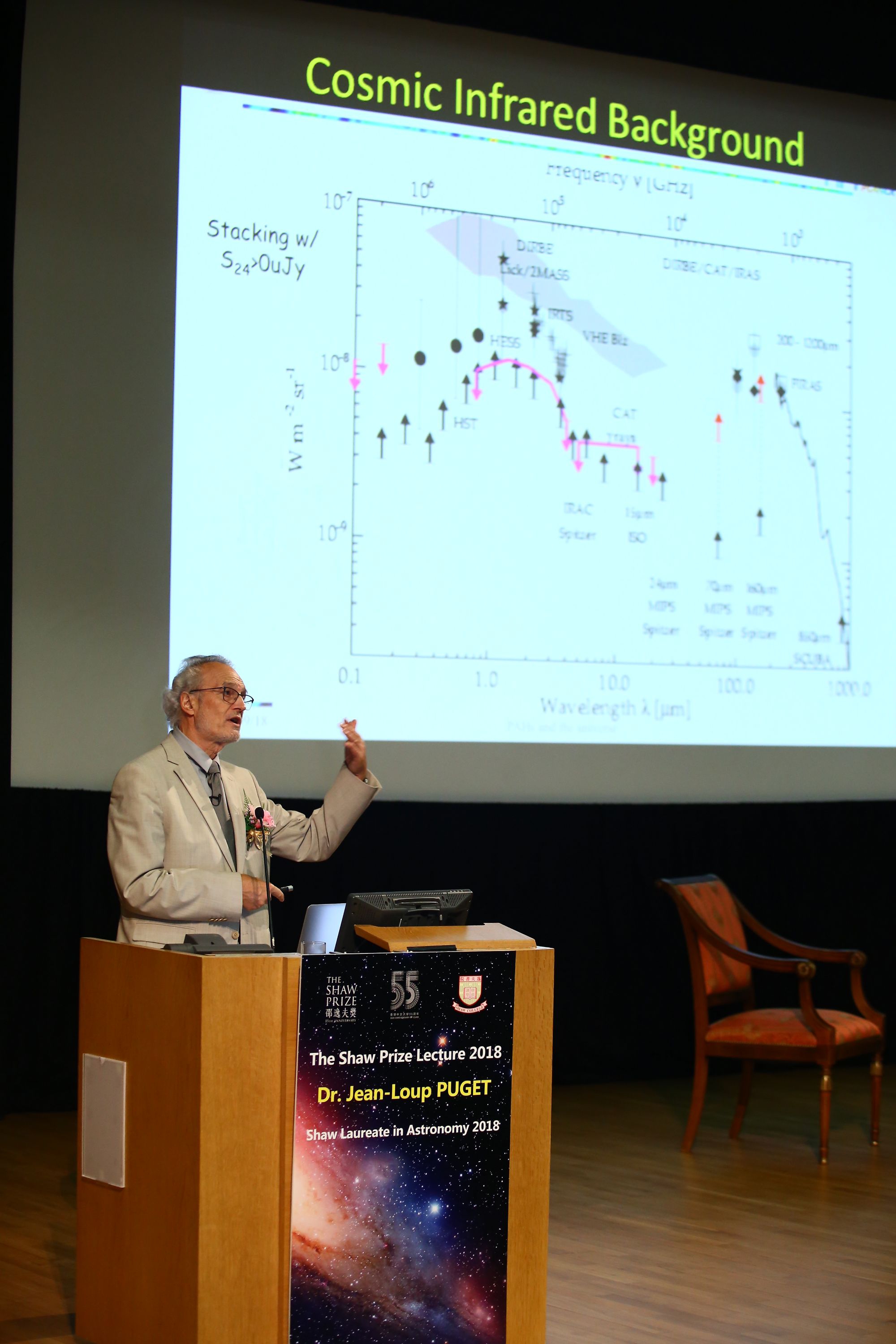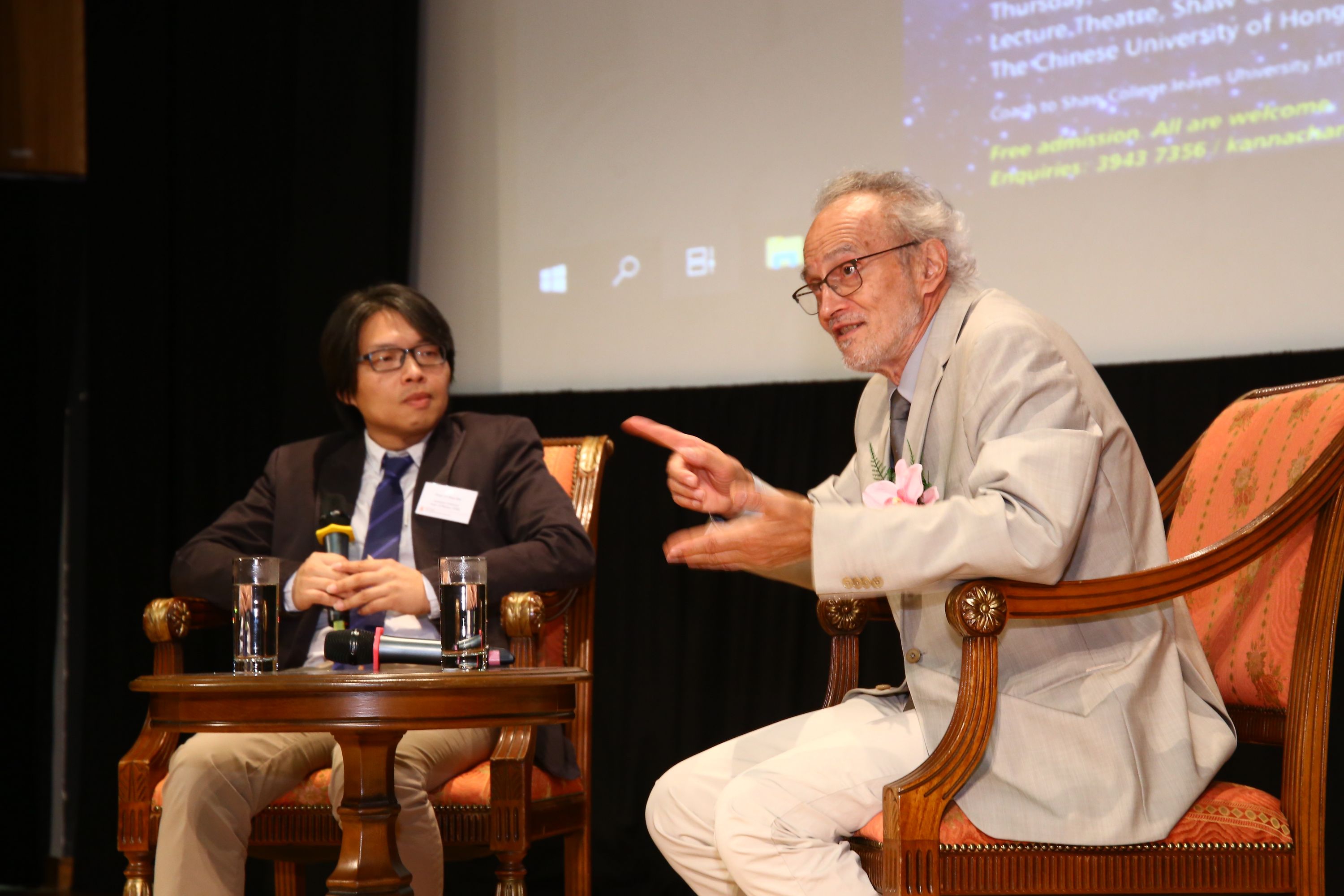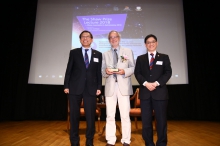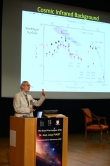News Centre
CUHK Hosts Lecture by Shaw Laureate in Astronomy 2018
Dr. Jean-Loup Puget, Shaw Laureate in Astronomy 2018, delivered a lecture at Shaw College of The Chinese University of Hong Kong (CUHK) recently. Dr. Puget spoke on ‘Space observations of the Cosmic backgrounds from infrared to microwave and their implications for galaxy evolution and cosmology’. The lecture attracted close to 400 people, including staff and students from CUHK and local universities, professionals in the field, as well as secondary school teachers and students.
The Shaw Prize in Astronomy 2018 was awarded to Dr. Jean-Loup Puget for his contributions to astronomy in the infrared to submillimeter spectral range. He detected the cosmic far-infrared background from past star-forming galaxies, and proposed aromatic hydrocarbon molecules as a constituent of interstellar matter. With the Planck space mission, for which he is the Principal Investigator of the High Frequency Instrument (HFI), he has dramatically advanced our knowledge of cosmology in the presence of interstellar matter foregrounds.
The infrared-to-submillimetre spectral range offers a unique window on the universe. Such radiation can pierce the obscuring material in the interstellar medium, while also probing the nature of that material. The longest wavelengths within this range, near 1 mm, also give information on conditions when the universe was around 400,000 years old, via the cosmic microwave background (CMB). Jean-Loup Puget has made pivotal contributions to all these areas.
Léger and Puget (1984) used spectral features in interstellar dust between 3 and 12 microns to argue for the presence of polycyclic aromatic hydrocarbon molecules in addition to solid dust grains as a major constituent of the interstellar medium.
Small dust grains are heated when they absorb ultraviolet radiation, and re-emit in the far infrared. The total intensity of such emission measures cosmic star formation, integrated over the entire history of the universe. The resulting 100-micron background was first detected by Puget et al. (1996).
The culmination of Puget’s work, building on his technical and scientific knowledge of far-infrared/submillimetre/millimetre astronomy, has been his leadership of the development and scientific exploitation of HFI on the European Space Agency’s Planck satellite. Between 2009 and 2013, Puget and his international team used HFI’s novel cryogenic sensors to measure the CMB plus the foreground emission due to the Milky Way’s dust and gas with superb sensitivity between 350 microns and 3 mm. By working at these short wavelengths, HFI has studied the CMB with an angular resolution three times better than any alternative all-sky CMB map. HFI is also uniquely sensitive to foreground dust emission, which dominates at short wavelengths. The ability to separate foregrounds was critical to the Planck results, which measure the cosmological parameters to exquisite precision — for example, the total density of dark matter is measured to 2% accuracy.
These precise results potentially allow us to probe within a small fraction of one second after the Big Bang, in the hypothesised inflationary era, when amplified quantum fluctuations may have created both the initial density fluctuations and relic gravitational waves. The gravitational waves would induce very weak distortions of the CMB, and their detection is challenging due to possible confusion with dust foreground emission. Planck’s precise foreground separation showed that the true level of primordial gravitational waves must lie below the predictions of the simplest inflationary models. It also showed that the density fluctuations are purely gaussian, with no detectable phase correlations. At a stroke, these results removed large classes of inflation theories from consideration. We thus still lack definitive evidence that inflation happened, and what exactly caused it — but we now know a great deal about what it is not.
Today, the universe expands in an accelerating manner. If Einstein’s relativistic theory of gravity is correct, this requires a non-zero vacuum energy density. Alternatively, the acceleration may indicate a modification of the strength of gravity on large scales, in which case density fluctuations in the universe would develop at a non-standard rate. Planck can test for this effect, because the CMB radiation is deflected by intervening mass fluctuations. This gravitational lensing effect has been mapped comprehensively by Planck, and matches the expectations of standard gravity. This work nicely closes a loop on Puget’s career, since the inferred foreground mass concentrations correlate in position with fluctuations in the far-infrared background: the dusty star forming galaxies whose integrated effect was first found by Puget more than two decades ago.
Finally, the CMB detects scattering due to ionised gas that is created by the first stars and quasars. The latest Planck data indicate that the onset of this reionisation era was more recent than previously supposed: within the last factor of ten of the cosmic expansion. This result complements the far-infrared background’s measurement of total energy release, closing in on a complete picture of the history of cosmic star formation.
Biography of Dr. Jean-Loup Puget
Jean-Loup Puget was born in 1947 in Chalon-sur-Saône, Saône-et-Loire, France and is currently a researcher at the Institut d’Astrophysique Spatiale (IAS) of CNRS and the University of Paris-Sud 11. He is also the Principal Investigator of the High Frequency Instrument (HFI) of the Planck Mission of the European Space Agency. He studied at Ecole normale supérieure de Cachan, France in 1966–1970 and received his PhD in 1973. From 1973, he was a Researcher and Director of Research at the National Centre for Scientific Research in France. He served as Deputy Director of the Institute of Astrophysics of Paris from 1978 to 1982. He then joined IAS in Orsay, where he was successively Deputy Director (1990–1997) and Director (1998–2005). He is a member of the Académie des sciences (France).
About The Shaw Prize
The Shaw Prize is an international award to honour individuals who are currently active in their respective fields and who have recently achieved distinguished and significant advances, or who have made outstanding contributions in academic and scientific research or applications, or who in other domains have achieved excellence. The award is dedicated to furthering societal progress, enhancing quality of life, and enriching humanity’s spiritual civilisation.
The Shaw Prize was established under the auspices of Mr Run Shaw in November 2002. It consists of three annual awards: the Prize in Astronomy, the Prize in Life Science and Medicine, and the Prize in Mathematical Sciences.





